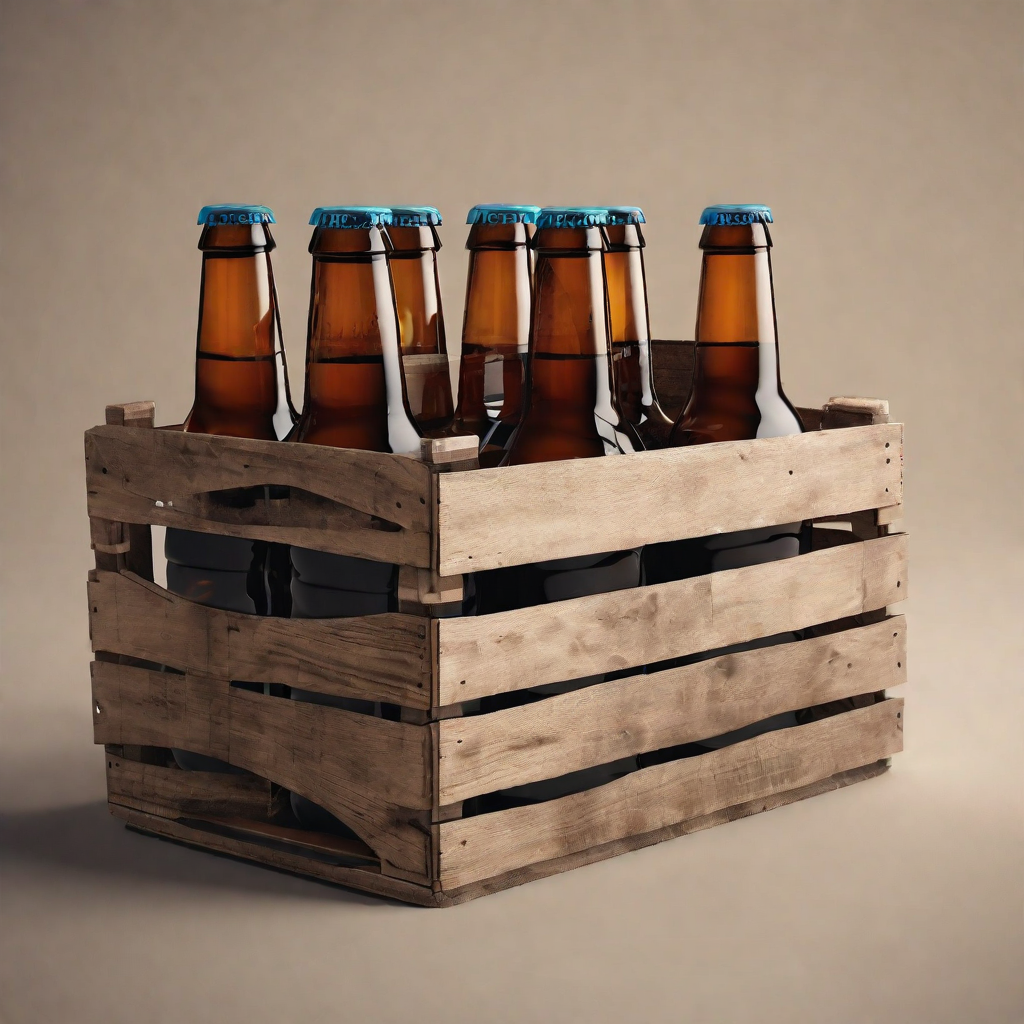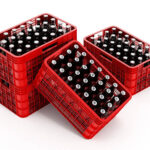Are you a beer lover looking for the perfect way to stock your fridge? Or maybe you’re trying to plan an event and want to know exactly how much beer you need? For any beer enthusiast, understanding how many beers in a case is essential. Whether you’re shopping for yourself or hosting a big bash, knowing that number can help make sure no one goes thirsty. In this blog post, we’ll discuss what the industry standard is for cases of beer and answer commonly asked questions about them so that you get exactly what you need.
Standard Beer Case Contents

| Lager |
Standard Case
|
24 cans/bottles (12 fl. oz. each) | Most common |
| Craft Beer | 24 bottles (12 oz. each) |
Common, but some variations exist
|
|
| Craft Beer (Large Format) | Magnum Case | 12 bottles (22 oz. each) |
Less common, but gaining popularity
|
| Cider |
Standard Case
|
24 cans/bottles (12 fl. oz. each) | Similar to lager |
| Seltzer | 24 cans (12 fl. oz. each) |
Increasingly popular format
|
|
| Imported Beer | 24 bottles (11.2 oz. each) |
European standard size
|
|
|
Keg
|
Size
|
5 gallons (64 12 oz. servings) |
Common for bars and restaurants
|
| 1/2 barrel (15.5 gallons = 192 12 oz. servings) |
Larger option for pubs and breweries
|
||
| 1 barrel (31 gallons = 384 12 oz. servings) |
Largest size, typically for breweries and distributors
|
||
|
Growler
|
64 oz. (equivalent to 5 12 oz. servings) |
Popular for refilling at breweries
|
|
| 32 oz. (equivalent to 2.5 12 oz. servings) |
Smaller option for single servings
|
Additional notes:
- Beer Count: The most common value is 24, but some specialized beers, like bombers, may come in cases of 12.
- Bottle/Can Count: Typically matches the beer count, but some variety packs may mix different-sized containers.
- Bottle/Can Size: 12 oz is the standard for North American cases, but other regions may use different sizes.
- Unit of Measurement: Indicates whether the count refers to bottles, cans, or another container type.
- Case Type: Categorizes the case based on its contents (standard, variety, craft, etc.).
- Region: Applicable for cases marketed in specific countries or continents.
Non-Standard Beer Case Sizes
While 24-packs may be the norm, plenty of exceptions exist:
- 12-pack – A popular option for smaller households or casual gatherings. More portable than 24-packs.
- 18-pack – Typically contains cans, an in-between option between 12 and 24 packs.
- 30-pack – Mostly 30-can packs, perfect for larger events and parties.
- 6-pack – Typically bottles, convenient for sampling new styles.
- Loose Single Bottles – No case, sold individually. Offers ultimate variety and flexibility.
The package type – bottles vs. cans – also impacts case size configurations. Bottle dimensions limit viable case sizes more than cylindrical cans. You’ll see more canned 18/30-packs than bottled ones for this reason.
Brand and Brewery Variations
Brewery types and individual brand approaches also influence beer case sizes:
- Craft breweries tend to offer more variety – 4/6/12-packs for flagship beers, seasonals in 6/12-packs.
- Macro breweries like Anheuser-Busch chiefly sell 12/18/24/30-packs of flagship lagers like Bud Light.
- Import brands like Heineken provide 12/18/24-pack cases to match domestic brands.
Then there are unique offerings like Corona’s 8-pack or Guinness’ 14-pack that add even more diversity. Brands experiment with sizes to stand out in stores and appeal to certain use occasions.
Regional Variations in Beer Case Sizes
Case sizes vary further once you look beyond the US:
- UK/Ireland – Cases of 4, 8, 10, 12, 18, 20, 24 are common. Brand names like Carling sell carboard 8/12-packs.
- Canada – Mostly 6, 12, 24-packs like the US, with a few odd varieties like 15-packs.
- Australia – One uniqueness is 30-can “slab” cases to service a strong drinking culture.
- Japan – Case sizes strictly follow tax regulations – 20 bottle cases and 10, 20, or 24 can cases only.
Cultural drinking habits and existing container size regulations greatly affect case size conventions internationally.
Packaging Material’s Influence on Case Size
The type of packaging used also shapes allowable case configurations:
- Glass Bottles – Heavier weight limits potential case sizes more than cans. Most common options are 6 or 12-packs.
- Aluminum Cans – Extremely lightweight and stackable. Enable large 18/24/30-pack cases.
- Plastic Bottles – Increasingly used for budget beer brands. Durable enough for large 24/30-pack cases.
Material waste and recyclability are also considerations. As sustainability grows more important, packaging choices may continue evolving.
Case Dimensions, Transport, and Storage
Standards for case dimensions also developed to maximize storage and shipping efficiency:
- Fridge/Cooler Storage – Cases sized to fit standard fridge shelves and coolers.
- Retail Shelving – Match common shelf dimensions in liquor/grocery stores.
- Pallet Transport – Enables stable stacking on pallets and transit without damage.
See more : How Many Beers In A Half Keg | Measure Beers In A Half Keg
Look for dimensions approximating 13”x10”x7” for a 24-pack case, with proportional sizing for smaller cases. Durability and ease of handling are also improved with uniform case sizes.
Beer Storage and Shelf Life
Proper storage helps maximize the shelf life of beer cases:
- Store cases in a cool, dark place around 55°F if possible.
- The fridge works for short-term storage, but takes up space and risks flavor loss by over-chilling.
- Pantries/cellars are suitable for larger case stockpiles, depending on climate conditions.
- Garages/outdoors are not recommended due to temperature fluctuations.
Following these guidelines, unopened beer cases should last:
- Non-craft beer – 2-5 months generally
- Craft beer – 2-6 weeks for hoppy styles like IPAs
- High ABV styles – 6-12+ months
So size your stash based on consumption rate, and avoid purchasing more than you’ll drink in peak condition.
Custom and Curated Beer Cases
Beyond standard configurations, some trending case options include:
- Custom 12/24-packs – Mix and match beer styles from a brewery.
- Beer subscriptions – Curated cases matching themes like seasonal brews.
- Build your own – Select brand variety packs tailored to your tastes.
These appeal to adventurous drinkers looking for more personalization and discovery from their cases.
Online Purchase and Delivery
E-commerce now allows beer cases to be bought online and delivered:
- Delivery is readily available in some regions based on local alcohol shipping laws.
- Certain states only permit in-state delivery, while select retailers can ship to addresses countrywide.
- Shipping costs vary based on case weight and your proximity to the sender.
- Delivery times range from 1-5 business days typically based on distance.
While convenient, online ordering does limit consumers’ ability to personally inspect case condition before purchase.
Seasonal and Limited Release Cases
Seasonality and exclusivity impact beer case availability:
- Seasonal varieties like summer saisons and winter lagers come in specially marked case packs.
- Limited editions and special releases have unique case designs and limited supply based on the batch size.
Finding these limited cases can be like a treasure hunt for dedicated beer fans seeking the newest offerings.
Evolution of Beer Case Sizes
See more : What does beer taste like | what causes beer taste change?
Beer originally shipped in wooden barrels before bottling and canning transformed portability:
- 1900s – Early 6-packs emerged but consisted primarily of heavy, risky glass bottles.
- 1930s – Advances in brewing and bottling enabled the reliable mass production of 24-bottle cases.
- 1960s – Lightweight cans gained prominence, allowing new large 30-pack configurations.
- 1970s-present – Craft beer diversified the market with smaller cases like 12 and 6-packs.
Ongoing innovations in materials, distribution, and consumer needs will likely continue advancing case size options.
Recycling and Sustainability

Environmental issues make proper case disposal important:
- Most bottle and can materials are readily recyclable, but cases often use recyclable cardboard and/or plastic.
- Rinse containers to avoid contamination. Break down boxes and follow local recycling guidelines.
- Some breweries take back cases for reuse or recycling – check a brewery’s website for such initiatives.
Consumers and brewers must work together to diminish the lifecycle impacts of beer production.
Comparative Analysis
Beer Cases vs. Beer Kegs
While cases suit household use, kegs have benefits for large gatherings and events:
- Volume – Full-size kegs hold over 120 12oz servings. Equivalent to 5+ cases.
- Freshness – Kegs maintain beer quality longer once tapped compared to cases.
- Cost – More economical per ounce, but higher upfront cost for the keg and tapping equipment.
- Portability – Kegs can be heavy and cumbersome for individual handling compared to cases.
- Dispensing – Kegs require proper tapping equipment and glasses for pouring. Cases just need a bottle opener.
Beer Cases vs. Beer Balls
Beer balls are stackable plastic containers holding 5 gallons:
- Single-Serve – Cases allow for individual bottle/can use, while beer balls are for large-scale dispensing.
- Beer Stability – Beer may oxidize faster in balls once opened. Bottles and cans maintain carbonation and quality longer.
- Brand Variety – Cases provide diverse options. Balls require bulk purchases of a single beer style.
- Transport – Balls take up substantial space. Cases are more modular for easy handling.
The convenience factor of cases makes them preferable for personal use for most consumers.
Factors to Consider When Buying
Case prices depend on the brand, package type, and volume:
- Brand – Craft, specialty, and imports cost more per case than major domestics.
- Bottles vs. Cans – Bottles tend to be pricier due to higher material costs.
- Case Size – The cost per beer decreases significantly as case size increases.
To maximize value, buying domestic cans in larger case volumes is your best bet. Just be sure to match quantities to your actual consumption. Leaving beer sitting for months risks flavor degradation and is wasteful.
You might be interested: what does beer taste like
Conclusion: How Many Beers In A Case
Beer cases come in many configurations based on brewing traditions, packaging innovations, regulations, and environmental considerations. While 24-packs represent the standard, a range of case sizes exist – from single bottles to massive 30-can packs. Understanding the case options for different brands allows you to tailor purchases to your specific tastes and occasions. Cases let you economically stock up on your go-to brews. Just be sure to moderate your purchases based on realistic consumption, storing cases properly to maintain optimal beer flavor.

Ronald B Gamrot is the owner of Silverking Brewery, one of the most successful craft breweries in North America. He started the business from scratch in his garage, and it has since grown into a multimillion-dollar operation. Ronald is passionate about brewing delicious beer and providing top-notch customer service. He is a respected member of the brewing community and often speaks at industry events.








Il existe différents types de cas. Certains sont proposés en 12 bouteilles, tandis que d’autres sont proposés en 24 voire 30 bouteilles.
It’s a case or a two four. If you are in BC (and maaayybbe Alberta), a case is 12, and a flat is 24. That’s how I remember it in the mid 90s when I worked out west.
In Canada it’s a 2-4. Flats are when you’ve got a bunch of cans in a cardboard thingy which is wrapped in plastic. They also don’t have a specific number of cans
I’m grateful for your input. It adds a valuable layer to the discussion.
Thanks for taking the time to comment. I appreciate the engagement.
You should refer to the beer number in a case before buying! I’m grateful for your input. It adds a valuable layer to the discussion.